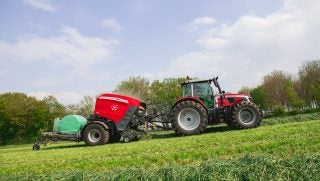No more than a century back, the U.S. dairy industry was 5.2 million farms strong. But since those golden days of dairy, a progressive decline has diminished the total number of dairy farms significantly. Currently, only 28,000 licensed dairy herds endure, according to the May 2023 USDA Milk Production Report.
No one is more acquainted with this decline than multigenerational dairy farmers fighting to keep their family’s legacy and livelihood afloat.
Fourth-generation dairy farmer Kate Steensma’s family witnessed the industry’s decline firsthand in their Whatcom County, Washington, community.
“When my dad was a kid, there were 12 dairy farms on our two-mile-long road. Today there are two active dairy farms,” Steensma said. “There were about 1,000 dairy farms in Whatcom County when my dad graduated high school in 1976. Today, there are about 50.”
Not only have the number of dairies fallen, but fluid milk sales have also dropped (down nearly 12 billion pounds since a peak in 2009, according to Hoard’s Dairyman).
While most dairies still depend on fluid milk sales for primary income, modern dairy farmers are realizing that supplementing fluid milk sales with the production of niche markets products may be the path forward to create a safety net for their family’s farming future.
“The milk check that my grandpa was getting in the mid-’70s? We still see those numbers regularly. But he wasn’t paying the inflation, fuel prices, labor, or feed costs of today. It’s squeezed a lot of people out,” Steensma said. “The only way for us to survive and to continue doing our model and supporting our family is to diversify and add a niche market product.”
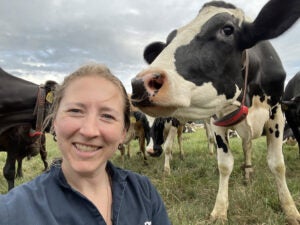
For the Steensmas, product diversification looks like a rich, creamy yogurt product: Icelandic Skyr. Steensma Creamery’s Skyr was born during the COVID-19 pandemic when Steensma perfected a recipe reminiscent of one she discovered during a trip to Iceland in 2018.
Farmer’s ingenuity kicked in as Steensma scaled her production. She created a prototype for a portable strainer (based off her grandfather’s 1960s-era milk strainer), found a dairy equipment manufacturer to fabricate it, found a local farmer who generously offered to rent her a production facility, and in October 2021, Steensma Creamery sold its first Skyr to a grocery store.
Today, Steensma Creamery turns between 140 to 200 gallons worth of milk into 70 to 100 gallons of Skyr each week.
“We do have shrink intentionally because of the whey that we drain off, which makes it such a nice creamy product,” Steensma said. “It looks expensive compared to other yogurts on the shelf, partly because of the labor at a small scale, but also because of the input level, [Skyr] is concentrated.”
Steensma’s Skyr is a labor of love and the fulfilment of a long time dream for their family.
“It was kind of a dream to maybe someday make our own cheese,” Steensma said. “I learned how to make yogurt when I was about eight or nine and then I did it as my 4-H demonstrations. I forgot about that until I started the [Skyr] business … this has been a long time coming.”
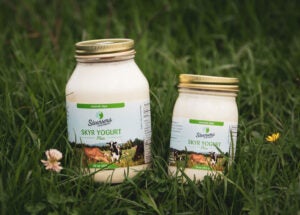
Many factors influenced Steensma along her journey from grade school yogurt maker to co-owner of Steensma Creamery. After Steensma completed her graduate program, her career at DeLaval, a full-service dairy equipment supplier, took her around the globe visiting dairy farms of different sizes and styles, notably across the western U.S., Canada, and Sweden.
But soon, Steensma felt the pull to come back home.
“I missed my own farm, I like the way we do things,” she said. “There are so many ways in dairy to manage well, but I really wanted to carry on our style of doing things.”
That style is one that was honed over the generations since Steensma’s maternal and paternal great grandparents immigrated to the U.S. from Holland in the 1920s and began dairying. The farm that Steensma, her parents and siblings co-own and still run today has been in their family since 1946.
About 1,000 miles down the Pacific coastline, the Diepersloot family has a similar story as multigenerational dairy farmers pursuing product diversification. Husband and wife duo, Rob and Erica Diepersloot, are the seventh generation to carry on a dairying legacy (both their dairying grandparents also immigrated from Holland. “I grew up on a dairy and I’m Dutch by heritage, but I didn’t mean to fall in love with a Dutch dairyman, that’s just a happy coincidence” Erica Diepersloot said, laughing).

The Diepersloots have farmed in Madera, California, since 1997. The family owns two dairy farms in California (totaling 12,000 head) and one in Colorado (with approximately 5,000 head). Running the operation is Rob, his father and one brother (yet another brother pastors the local church the Diepersloots attend).
The Diepersloots emphasize that even though their operation is large, “We still very much are a family dairy,” Rob Diepersloot said. “We look at it like we are supporting 150 families as employees through this operation. It’s a family environment.”
Family is at the very heart of why they created their niche market dairy product, WonderCow, a powdered colostrum supplement.
In 2017, the Diepersloots welcomed their first child. Unfortunately, their new daughter began dealing with recurrent ear infections, which led to overuse of antibiotics, impairing her gut health (a system closely linked to the immune system).
“We became really passionate to find a way to rebuild her gut health and hopefully help her immune system, and it’s amazing that the answer to a holistic solution was right in our backyard,” Erica Diepersloot said.
The Diepersloots were no stranger to the benefits of colostrum (Rob Diepersloot’s senior project in the Cal-Poly Dairy Science program studied colostrum: “I wrote a 30-page paper on just colostrum alone,” he said. The project included a trial that followed 300 calves from birth to production to study the impact colostrum as well).
Armed with knowledge of the power of colostrum for young, growing bodies, the Diepersloots decided to see if their daughter could benefit and “the results kind of blew us away,” Rob Diepersloot said.
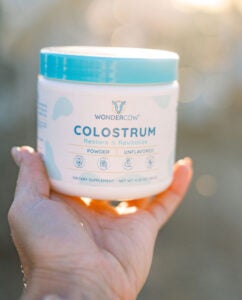
With their personal success story and colostrum already being produced on their farm, it was like a no-brainer for the Diepersloots to build a brand. Today, the Diepersloot dairy’s colostrum is gathered, shipped to a third-party processing plant to be pasteurized and powderized before being delivered to the consumer’s doorstep. What started as new parents passionate about their daughter’s health turned into a product for people of all ages.
“So many people have similar issues and other issues that colostrum targets,” Erica Diepersloot said. “We’ve had a lot of positive reviews of people who had been struggling with digestive issues and colostrum is what’s helping them rebuild that health.”
A new way to approach health became a new market for these dairy farmers. But farmers interested in pursuing a niche market product shouldn’t think they need to ditch their traditional income streams. The Diepersloots and Steensmas still ship fluid milk to their state’s respective dairy cooperatives.
“We have 200 cows, but only a few cows’ worth of milk is going into our Skyr production each week,” Steensma said. “We definitely need that. You can’t just make a market overnight.”
The Diepersloots echo Steensma’s sentiment, understanding that entering a new market has pros and cons.
“Taking on a new company, a new product, there’s tremendous risk within that, but long term, if you can push through it, it minimizes risk because now you’re not fully dependent on just selling a commodity you have other products as well,” Rob Diepersloot said. “The diversification is key, long term it minimizes risk.”
The cons? “Just getting through that risky period of a startup. It’s fun to work together as husband and wife but we are also operating a farm and raising three girls,” Rob Diepersloot said. “At a certain point in our evenings we just have to push the off button. Finding that work/life balance is important.”
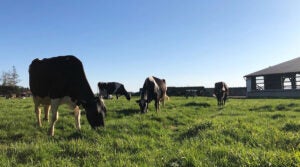
The work that the Steensma and Diepersloots are doing impacts more than just their families. This next generation of farmers are making great strides towards environmental sustainability as well as promoting animal welfare.
The Steensmas use the practice of rotational grazing on their farm (Steensma’s mom, a biology professor, appreciates the benefits rotational grazing has on the environment, her dad reaps financial benefits from harvesting dry matter off fields that cows would have otherwise grazed down). But farmers and cattle aren’t the only beneficiaries of rotational grazing practices. Steensma (who did her master’s project on the topic) explained: Marketing their product helps inform the public how farmers care for the land and animals.
“As consumers get more and more removed from their food, they are afraid of how [animals] are being raised, are they being treated properly,” she said. “If I was going to be a cow, I would want to be a cow on my farm. Those are our cows on the label; that is literally our farm. People love that, it blows their mind. “
“No one cares more about our land and cows than we do, and our profitability depends on it,” Rob Diepersloot concurs.
Marketing a niche product has broadened the Diepersloot’s audience to promote the industry.
“Modern dairy [has] a completely new story with the methane digesters and feed additives that are reducing methane,” Rob Diepersloot said. “We have a digester ourselves that captures all the methane, goes through fuel cell technology, turns into electricity and powers our whole farm.”
The Diepersloots aren’t the only ones, explaining that 200 digesters that have been installed in California alone over the past couple years to reach the goal of carbon neutrality by 2050.
“People need to realize we are environmentalists as dairy farmers,” Rob Diepersloot said. “It used to be all about ‘cows are leading global warming’, well now there’s actually a cow cooling effect. We’re doing the opposite, that’s the reality of it.”

The Diepersloots expect that their product can have a positive impact on the dairy industry as a whole.
“Right now, the colostrum is going into lower value products, animal products. When you bring it into the [human] supplement category, you’re adding a lot more value,” Rob Diepersloot said. “There is a finite supply, and we can increase demand which we are doing, then the competition for that demand goes up and hopefully [creates] higher revenue for the farmers.”
While this limited supply of colostrum spells financial benefit for the Diepersloots, cattle care is still paramount as illustrated by WonderCow’s Calf First Promise.
“The mama cow produces more colostrum than what her baby needs, so the baby calf gets what she needs first and then WonderCow colostrum is the excess colostrum that she produces,” Erica Diepersloot said.
The Steensmas and Diepersloots are blazing the trail for dairy farmers of the future. By capitalizing on diversifying to niche market products and promoting the positive impact of dairying on the world, perhaps a long-suffering industry can survive, even thrive.
Maggie Bright is a small farmer who was born and raised in Washington state. Maggie grew up showing dairy cattle in 4-H and currently works part-time as a relief milker on a local registered Holstein dairy. Maggie is passionate about highlighting the people whose innovation and ingenuity fuel the future of agriculture.



